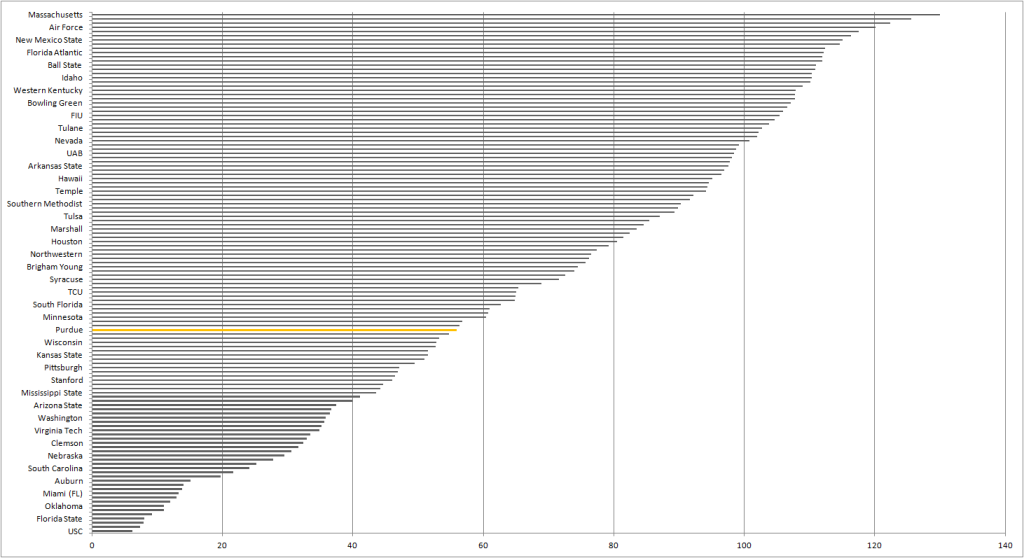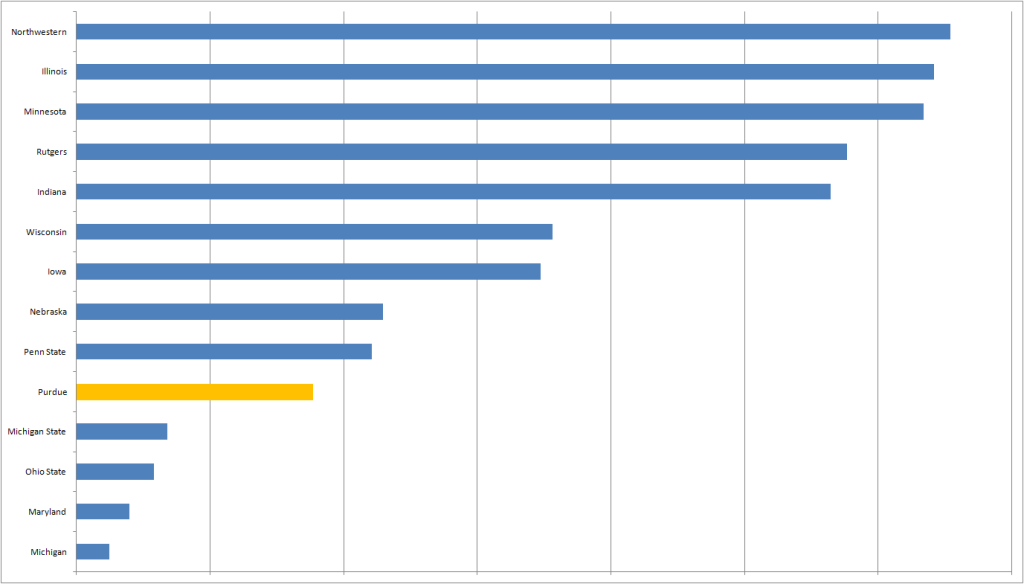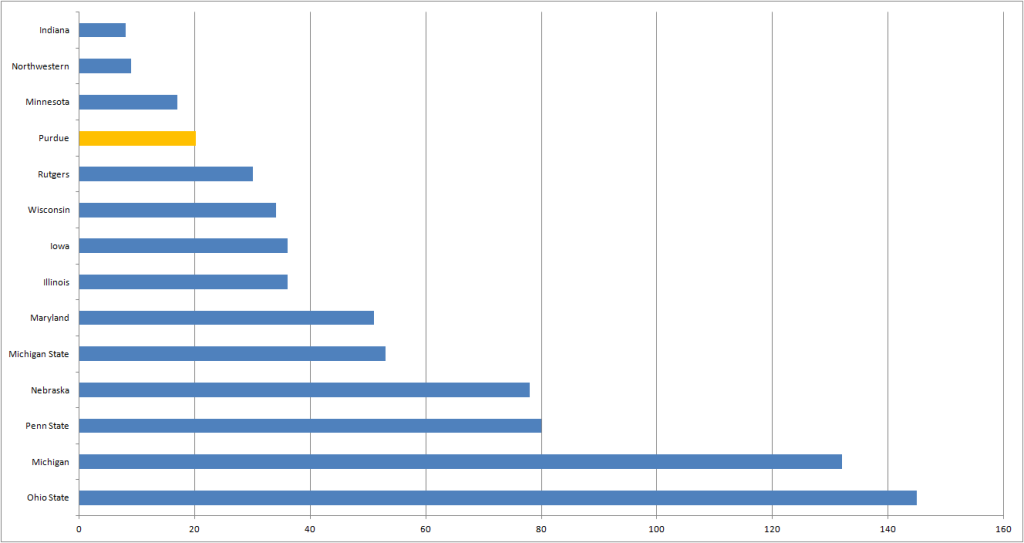It's the summer, which means that no one has anything to talk about in either of Purdue's two major sports other than recruiting. A lot of (digital) ink has been spilled within Purdue's fanbase discussing Purdue's role within the college football landscape, both in terms of where we are today, and where we can reasonably expect to be. No one expects us to turn into Alabama anytime soon, but is a Big 10 championship now and again too much to ask? Maybe.
But while considering that larger question, I decided to first take a look at where everyone takes their first look when evaluating their favorite college football team: recruiting. What follows is a reasonably shallow evaluation that nevertheless can provide some insight into the state of our football program's recruiting. Before we get into that, let's set up the problem.
ANALYTIC QUESTION
It's important to understand what we're looking for before we even start. By looking at this data (more on that later), I wanted to learn more about two facets of Purdue football. 1.) How does Purdue football recruiting stack up to the other Division-I football programs, and 2.) How does Purdue football recruiting stack up to the rest of the Big 10 (in my opinion, the more important question).
DATA
There's not shortage of recruiting data, but unfortunately, a lot of it is crap. That's not to say that each major recruiting service doesn't have it's value, but there's an overwhelming amount of information out there these days, and frankly, only about 20% (my opinion) is worth anything. To mitigate that, I used data from only one service, the service I trust the most because they have the longest track record of being the best: Rivals.com. The data I used was the Rivals.com team recruiting rankings for Division I football from 2002--2014, as well as their star rankings for players recruited in those years.
ANALYSIS
I'm going to evaluate Purdue's recruiting effort on two factors: their team recruiting rankings, and the stars assigned to their recruiting. A quick note: the failings of recruiting services has been evaluated ad nauseum. I will acknowledge: 1.) Services mis-evaluate players frequency, 2.) Service are susceptible to sucumming to hype, 3.) How much exposure a player receives often influences how they are evaluated, 4.) There are literally thousands of high school football players; saying that you have accurately evaluated them and ranked them and the teams that sign them is ludicrous, and 5.) Along with that, the NFL is full of players these services completely missed and gas stations around the country are full of "can't miss" prospects who missed.
Having said all that, the evaluations from a trusted service (in this case, Rivals.com) is good enough to trust for this type of analysis because: 1.) Their livelihoods depend on being "as right" as possible, so they have a vested interest in being accurate, 2.) They watch more high school football, 7-on-7s, and camps than anyone outside of a Division I coaching staff, 3.) They have more candid conversations with those in the know (Division I coaching staffs) than a lay person, and 4.) They are experienced in doing their jobs.
Therefore, I'm comfortable saying that the data I'm using is both subject to bias and human error, yet good enough to at least provide some insight. It's not perfect data, but no real-world data set is perfect. Let's proceed.
Question #1: How does Purdue's ranking stack up to the rest of Division-I?
To answer this, I looked at Purdue's mean team recruiting ranking from 2002 to 2014. The result is shown in the image below (click on the link to see the full resolution).
Purdue's mean rank since 2002 has been 55.7, good enough for 49th best over that time period. The five ahead of Purdue are (in order): Oregon State, Colorado, Wisconsin, Illinois, and Rutgers. The five behind Purdue are (again, in order): Kansas, Louisville, Minnesota, Kentucky, and Georgia Tech.
The mean ranking tells a part of the story, but I also wanted to see how stable that ranking is. So I ranked all of Division-I football in order of their rankings variance. For those of you unfamiliar with statistics, variance is the measure of how spread apart a distribution of numbers are. The square root of the variance is the standard deviation, which is a measure that can be used to determine how anomalous a data point is in comparison to an expected value (the mean). Therefore, with team recruiting rankings, a low variance may be a good thing; it's one indication that a school generally brings in the same level of class year after year. The variance in recruiting rankings across Division-I is shown below:
Purdue's ranking in terms of variance is not bad at 25th overall. Keep in mind that Purdue has had three head coaches since 2002, and has remained pretty steady in the level of talent that they're bringing in. There are some positives to this (namely, Purdue avoids the "boom and bust" cycle that a lot of programs struggle with when trying to gain some consistency), but given that their average team ranking is right around 56th, the point can be made that Purdue is good at consistently bringing in mediocre classes.
Question #2 - How does Purdue stack up to the rest of the Big 10?
Purdue does not have a national recruiting presence, at least not at a high level. Purdue has had success going into other states (Texas and Florida, specifically) and picking up undervalued players who the regional big boys ignored. But Purdue is not capable of pulling top-tier talent from outside of their region.
Which mean it may be more important to judge Purdue based on how they recruit against their main conference rivals, with whom they are geographically associated with as well. So I ranked Purdue vs the other teams in the Big 10 based on their mean recruiting ranking:
And their variance:
As you can see, Purdue is one of the most consistent programs from a recruiting standpoint in the Big 10. And as you can also see, Purdue routinely pulls in some of the worst classes in the Big 10, outranking only Minnesota (not exactly a powerhouse, having last won a conference title in 1967; a title they shared at that), Northwestern (a doormat until very recently), and Indiana (perhaps the worst high major football program of all time).
What about other measures of recruiting success? Let's look at the star rankings. First, the number of five star recruits over that period:
Four stars:
And finally, three stars:
Again, how far behind Purdue lags the rest of the conference is as clear as day in those charts. What Purdue has been great at has been turning those two and three star recruits into serviceable players (and at times, future NFL stars). But Purdue has failed to take that next step in getting that next level of talent necessary to be an impactful player in the Big 10.
The following is a per-year listing of Purdue's ranking, with the color indicating how it compares to the mean:
CONCLUSION
College football exists in tiers, from your elites (Alabama) to your bottom-dwellers (Indiana) and different stratifications in between. All time, Purdue could be generously described as mediocre. Occasional moments of (near) greatness, bookended by years that alternate between terrible (1-11) and barely acceptable (6-6). Moving up a level for Purdue means getting to eight wins far more frequently (Purdue has hit at least eight wins only three times since 2002 and has only won 10 games once since 1960; and that was in 1979) and challenging for higher level bowls more frequently. Doing so starts with recruiting, and as the data shows, Purdue has a lot of ground to make up there yet.
It remains to be seen if Purdue will ever get there, but there are plenty of positive signs out of West Lafayette. Darrell Hazell hasn't been bringing in trucks of top-100 talent, but at least this summer he has done an excellent job of getting commits from his top targets (credit is also due to his staff, Marcus Freeman in particular). He has also clearly put the focus on getting local kids, which is a strategy in stark contrast to Danny Hope, who thumbed his nose at Indiana football to concentrate on second- and third-tier recruits from the south.
Recruiting is #1 about building relationships, establishing a presence, and delivering on promising to lead kids to where they want to go (quality education, winning records, high-profile bowl games, the NFL, whatever). There hasn't been enough time to pass judgement on Coach Hazell just yet, but the momentum they've built this summer may be reason enough to be hopeful. Time will tell.











